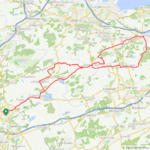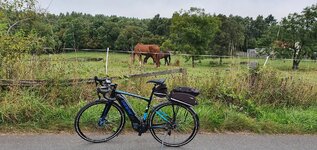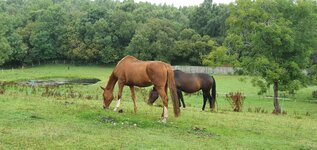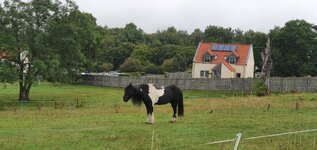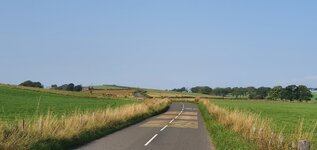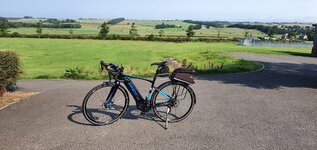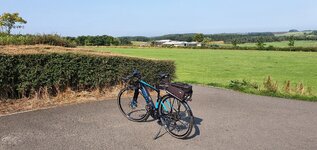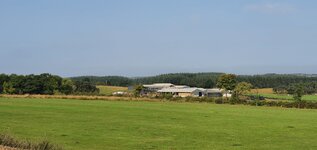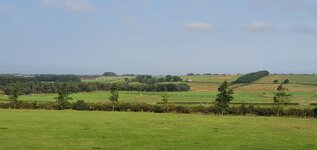Stefan Mikes
Gravel e-biker
- Region
- Europe
- City
- Mazovia, PL
"What If I Discarded My Present Life And Escaped To Bieszczady?", or Ursa Maior Brewery Ride
(Wednesday 18th of August 2021. Base: Ustrzyki Dolne)
The phrase circulates between bored city dwellers of Poland as a joke. For us, Bieszczady Mountains (that are located in the most remote southeast corner of Poland, in Ukraine, and in Slovakia) are the synonym of the area where you're going for refuge. I had exactly the same thought on last Tuesday when I asked my my boss to let me take the next part of my vacation ad hoc. And Jacek lent me his car to facilitate my travelling. In the light of a terrific weather breakdown of today (Monday 23rd of August), my decision to travel instantly appeared to be very smart.
Jacek had also taught me a lesson to ride just after the arrival to the chosen base to learn the terrain specifics and not waste a single day. My FB friend a.k.a. Watman asked me in a comment: "Why don't you just ride to the Ursa Maior Brewery as soon as you arrive to Ustrzyki Dolne? Greatly recommended!" As soon as I arrived at "overnight accommodation" (more on it later), after 8 1/2 hours spent in the car trip, I set off for a side-roads mountain ride (15:39). And something was telling me I should better hurry, so I was riding at high tempo!
And I was right: the brewery was closing at 17:00. I was just in time there!

Ursa Maior (Craft) Brewery is unique as for the area. Created by the iron will of Ms. Agnieszka Łopata, the facility only brews unfiltered and unpasteurized ales and stouts, and sells them at hefty price, mostly in the region. (Unpasteurized beer does not hold well so it has to be sold and drunk rather quickly). Against all criticism, Ms Łopata has been able to successfully grow her business; her beer is widely available throughout the region (but is rather unavailable outside Bieszczady). The brewery is only powered by solar panels, and even offers a charging station for EVs!

At the bar. The brewery makes six regular beer styles and occasional special brews. The brewery logo is a large she-bear (Ursa Maior). The brewery is also reiterating on the wolf and rebellion themes.

As in any class craft beer brewery, you can watch the production process.

Brewing education: Components, mashing, filtration, brewing, fermentation, maturation, bottling, storage & distribution.

Similarly to any good American craft beer brewery, Ursa Maior has a restaurant and a merchandise store. Unique is the part devoted to the beer vinegar, a novelty.

I ordered a litre and a half of "Wataha" (Pack of Wolves) 7.2% Strong Ale, and a small glass of "Renegat" (Renegade) 6% Black IPA. (Mineral water bottle was used).

I was returning to Ustrzyki Dolne by side-roads, over Góry Słonne (Austrian German: Berge Saana, English: Sanok Mountains). These are not Bieszczady, as Bieszczady are located in all directions southwards of Ustrzyki Dolne.

A mare with a colt.

Only 10% grade short climb? Hahahah! I eat these for breakfast!
 \
\
Still in Góry Słonne.

Poland's domestic natural gas production covers 20% of the demand. We also produce a small amount of crude oil. There are many small oil & gas mining fields in the area. You can actually smell crude oil there! (What was the English name for this machine?)

Ustrzyki Dolne is the capital city of Bieszczady. More precisely, it is the "capital of the Bieszczady County" (as it is proudly named). There is a single good restaurant in the town, and I used to have dinners there. Yes, I started eating that regional meal to show you the structure. "Hryczanyk" (regional Ukrainian meal) is a ball made of meat and buckwheat groats. All in fungi sauce. Delicious! As I got me another half litre of "Renegat" ale to the dinner, I had to walk my Vado to the "overnight accommodation"!
A word on "overnight accommodation" (Polish: "noclegi"). Avoid at any cost, or get prepared. A "nocleg" is like Bed & Breakfast minus breakfast, towels, and toilet paper (Fortunately, I could make shopping in the town but I could not buy a towel because it was always too late!)
(Fortunately, I could make shopping in the town but I could not buy a towel because it was always too late!)

Ride Map and Metrics. Note pretty high average speed: I was in hurry!
(Wednesday 18th of August 2021. Base: Ustrzyki Dolne)
The phrase circulates between bored city dwellers of Poland as a joke. For us, Bieszczady Mountains (that are located in the most remote southeast corner of Poland, in Ukraine, and in Slovakia) are the synonym of the area where you're going for refuge. I had exactly the same thought on last Tuesday when I asked my my boss to let me take the next part of my vacation ad hoc. And Jacek lent me his car to facilitate my travelling. In the light of a terrific weather breakdown of today (Monday 23rd of August), my decision to travel instantly appeared to be very smart.
Jacek had also taught me a lesson to ride just after the arrival to the chosen base to learn the terrain specifics and not waste a single day. My FB friend a.k.a. Watman asked me in a comment: "Why don't you just ride to the Ursa Maior Brewery as soon as you arrive to Ustrzyki Dolne? Greatly recommended!" As soon as I arrived at "overnight accommodation" (more on it later), after 8 1/2 hours spent in the car trip, I set off for a side-roads mountain ride (15:39). And something was telling me I should better hurry, so I was riding at high tempo!
And I was right: the brewery was closing at 17:00. I was just in time there!
Ursa Maior (Craft) Brewery is unique as for the area. Created by the iron will of Ms. Agnieszka Łopata, the facility only brews unfiltered and unpasteurized ales and stouts, and sells them at hefty price, mostly in the region. (Unpasteurized beer does not hold well so it has to be sold and drunk rather quickly). Against all criticism, Ms Łopata has been able to successfully grow her business; her beer is widely available throughout the region (but is rather unavailable outside Bieszczady). The brewery is only powered by solar panels, and even offers a charging station for EVs!
At the bar. The brewery makes six regular beer styles and occasional special brews. The brewery logo is a large she-bear (Ursa Maior). The brewery is also reiterating on the wolf and rebellion themes.
As in any class craft beer brewery, you can watch the production process.
Brewing education: Components, mashing, filtration, brewing, fermentation, maturation, bottling, storage & distribution.
Similarly to any good American craft beer brewery, Ursa Maior has a restaurant and a merchandise store. Unique is the part devoted to the beer vinegar, a novelty.
I ordered a litre and a half of "Wataha" (Pack of Wolves) 7.2% Strong Ale, and a small glass of "Renegat" (Renegade) 6% Black IPA. (Mineral water bottle was used).
I was returning to Ustrzyki Dolne by side-roads, over Góry Słonne (Austrian German: Berge Saana, English: Sanok Mountains). These are not Bieszczady, as Bieszczady are located in all directions southwards of Ustrzyki Dolne.
A mare with a colt.
Only 10% grade short climb? Hahahah! I eat these for breakfast!
Still in Góry Słonne.
Poland's domestic natural gas production covers 20% of the demand. We also produce a small amount of crude oil. There are many small oil & gas mining fields in the area. You can actually smell crude oil there! (What was the English name for this machine?)
Ustrzyki Dolne is the capital city of Bieszczady. More precisely, it is the "capital of the Bieszczady County" (as it is proudly named). There is a single good restaurant in the town, and I used to have dinners there. Yes, I started eating that regional meal to show you the structure. "Hryczanyk" (regional Ukrainian meal) is a ball made of meat and buckwheat groats. All in fungi sauce. Delicious! As I got me another half litre of "Renegat" ale to the dinner, I had to walk my Vado to the "overnight accommodation"!
A word on "overnight accommodation" (Polish: "noclegi"). Avoid at any cost, or get prepared. A "nocleg" is like Bed & Breakfast minus breakfast, towels, and toilet paper
Ride Map and Metrics. Note pretty high average speed: I was in hurry!
Last edited:

